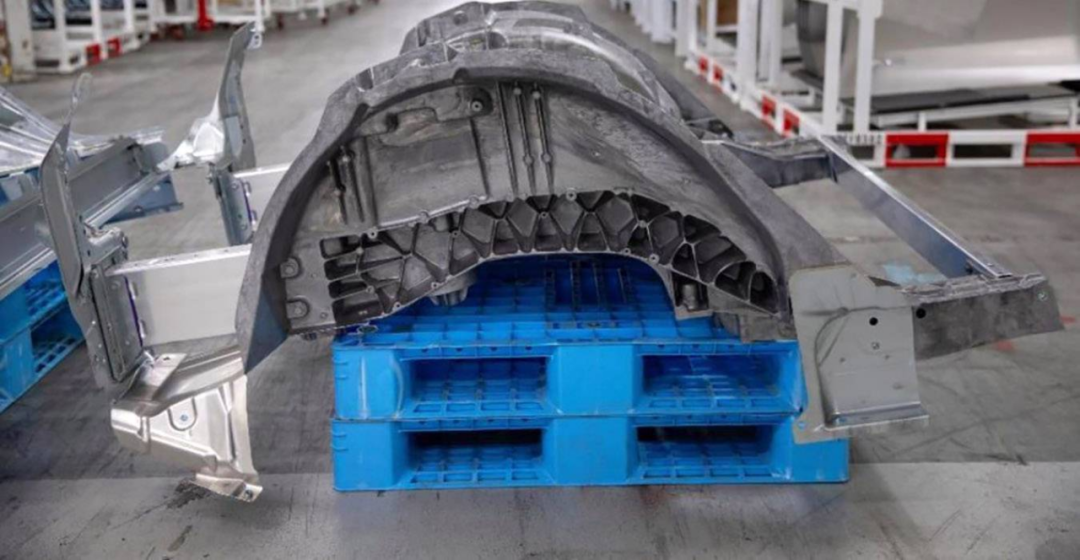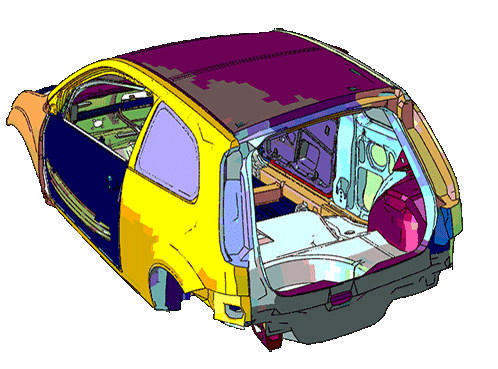This article is reproduced from the autocarweekly official account
Author: HOO
“The new XXX (a car model) uses a large amount of high-strength steel, and the torsional rigidity has increased by xx%, ensuring excellent collision safety.”
This description has appeared in countless car reviews and has become a common, standard language that is often mistaken. Even professional reviewers may not understand the difference between “strength” and “rigidity” – and in fact, many consumers may not be aware that “strength” and “stiffness” are completely separate issues.
In fact, it’s not that complicated. You don’t need to pass high school physics to understand these two concepts and what they determine.
The body, or rather the body-in-white (BIW), is perhaps the most overlooked and underestimated subsystem of a car body, especially in this “smart” era. Perhaps most people have never realized that the “iron shell” of a car is actually a technologically intensive thing.
Tesla’s cool one-piece cast aluminum body is not just about “improving efficiency and reducing costs”.
There are many metrics for evaluating the structure of a car body, but the most common ones are strength and stiffness. First of all, you already know that strength is not the same as stiffness, and each has its own characteristics. Among them, strength, not stiffness, is truly related to “collision safety”. Anyone who mixes up “stiffness” and “strength”, or uses stiffness to argue for safety performance, can be pronounced to have zero knowledge of the car body.
The so-called “stiffness” refers to the ability of the car body structure to resist elastic deformation, while “strength” refers to the ability to resist deformation, fracture, and damage. Simply put, when the car body is subjected to external forces, if the car body can restore itself after the external force disappears, then this tests the “stiffness”; if the car body is already deformed or damaged after the external force disappears, then this tests the “strength”.
There is almost no inherent or direct relationship between stiffness and strength. In daily life, there are examples of high strength and low stiffness, such as rubber erasers, which can be easily twisted but are difficult to break; there are also examples of high stiffness and low strength, such as glass, which requires a lot of force to deform but can easily break when lightly dropped on the ground.Stiffness is easy to quantify. You may have heard of the term “anti-torsion stiffness xxxx N・m/deg” for some car models. How to understand stiffness? A car body is not just a lump of iron. The body is a huge hollow frame. Even during normal driving, some deformation that is not easy to observe with the naked eye and can automatically recover when the external force disappears will occur due to the influence of external forces. The ability to resist this kind of deformation is the stiffness of the body.
For example, the unit of torsional stiffness, such as 1000 N・m/deg, means that the entire body will rotate by 1 degree when subjected to a torsional moment of 1000 N・m at the standard constraint point. The commonly used methods for body testing are bending stiffness and torsional stiffness, among which the latter is the most representative.
The level of body stiffness will directly affect the body’s resonance frequency, affecting the vehicle’s NVH performance, and even in some extreme cases, may affect the vehicle’s ultimate handling performance and off-road performance.
On the other hand, the strength of the body structure is what really affects collision safety, and the stress should be on the word “structure”.
The strength of the structure is not easy to quantify. What can be quantified is the strength of the material (how many megapascals). The strength of the structure should be viewed separately from the strength of the material. Car manufacturers like to emphasize the type of steel they use, whether it is “high-strength steel” or “ultra-high-strength steel”, and the strength is up to how many megapascals (MPa), etc. These are all used to describe the strength of materials. However, you should be aware that material strength ≠ structural strength.
The reason is simple. The tensile strength of human hair can reach 260 MPa, which has already reached the yield strength of high-strength steel used in cars, but you would not think your hair is stronger than car steel. Material strength is only one basic variable. Besides, component structural design, physical dimensions, and connections between components (when raised to the level of the entire vehicle) together determine the structural strength of the component/vehicle.
It is like building a wall with bricks. Using the best bricks does not mean that the strongest wall will be built in the end. Making the wall thicker, using cement with stronger adhesion, and reinforcing it with steel bars can allow inferior bricks to build a better wall. What really determines the quality of the house and the safety of human life is the overall strength of the wall, not the strength of a single brick.
Stiffness and strength cannot be equated. In some cases, the two need to be balanced.Translated English Markdown text with HTML tags preserved:
When we hear about “Ultra-high Strength Steel” that strains our ears, it’s basically harmless for body strength, but not necessarily stiffness. Because of the set collision regulations, there are certain standards that carmakers have to adhere to concerning the body strength during a whole car collision. So, if we use higher strength steel, such as from high strength to ultra-high strength, while keeping the integrity of whole-car strength standards, in the trend to reduce weight, we will almost certainly use thinner ultra-high strength steel.
However, there are only two variables that determine stiffness: the material’s modulus of elasticity, thickness, and cross-sectional area. Among these, the modulus of elasticity is almost entirely dependent on the material. Different steel strengths have very little difference in modulus of elasticity. If they are all steel, stiffness only depends on thickness/cross-sectional area. This means that the phenomenon may occur where we use more ultra-high strength steel, causing body stiffness to decrease, which might in turn lead to embarrassment when NVH performance is affected due to safety and weight reduction.

Therefore, one should never listen to high-strength, ultra-high-strength steel and believe that it is only good and without any disadvantages. The composite materials for automotive bodies are the trend. High-end cars and high-performance cars extensively use aluminum and carbon fiber, and the mystery lies therein. The modulus elasticity of aluminum is only one-third of steel but, because aluminum is much lighter than steel, and cast aluminum can have its reinforcement structure freely set up, we can flexibly increase thickness in key areas when using aluminum. This guarantees/improves the stiffness while reducing weight.
So, as said above, solving this problem isn’t difficult. One option is to utilize our fiscal strength and use different (expensive) materials at the appropriate locations. Ultra-high strength steel, aluminum, especially cast aluminum, and carbon fiber can all be considered. In the meantime, we must adapt fabrication processes and procedures at different material intersections (we can’t simply weld steel to aluminum). Then, with the production line up and running, wealth will be gained.

Another option is to reduce the car’s size and the space used. A smaller body means lower weight, less pressure to reduce weight, and smaller space requirements, which allow us to use thicker materials to increase cross-section and improve stiffness at the cost of space. Therefore, at the same price point, making a car smaller, and reducing the space requirements, in essence, can be considered another type of fiscal strength.
This article is a translation by ChatGPT of a Chinese report from 42HOW. If you have any questions about it, please email bd@42how.com.